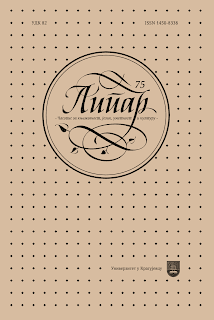СТИЛ И ЈЕЗИК КНЕЖЕВОГ ДНЕВНИКА У РОМАНУ „БЕЗДНО“ СВЕТЛАНЕ ВЕЛМАР-ЈАНКОВИЋ
THE STYLE AND LANGUAGE OF THE DUKE’S DIARY IN THE NOVEL "BEZDNO" BY SVETLANA VELMAR-JANKOVIĆ
Author(s): Ivana S. ŽivančevSubject(s): Language and Literature Studies, Studies of Literature, Serbian Literature
Published by: Универзитет у Крагујевцу
Keywords: “The Diary” of the Duke Mihailo Obrenović;the Dositej language;Slavonic-Serbian stylistic and linguistic elements;archaisms
Summary/Abstract: In this paper, we dealt with the specific style and language of “The Diary” of the Duke Mihailo Obrenović in the novel Bezdno by Svetlana Velmar-Janković. We focused on the characteristics of the Slavonic-Serbian language. Our aim was to point out the stylistic and linguistic elements of this language and to analyze the historical and political circumstances that caused its creation. Special attention was given to numerous archaisms, which helped the writer to bring the spirit of this period to life. In order to detect and explain this style and language, we refered to the teachings of Aleksandar Mladenović. While trying to establish which version of the Cyrillic alphabet was actual at that time, we took Petar Đorđić’s book The History of the Serbian Cyrillic into consideration. We tried to explain the social circumstances which were a fruit- ful ground for the creation of this hybrid and inconsistent language thanks to Jovan Skerlić. We came to the conclusion that the Duke was fond of a specific version of the Slavonic-Serbian language – the Dositej version, which preserved the elements of the Slavonic-Serbian language primarily on its lexical level, while morfological and phonological levels remained the same. The Duke’s style and language altered during his writing. Later on, they resembled vernacular Serbian language more. In order to establish the role of archaisms in this novel, we made a list of them and noticed that Russian Church Slavonic, Slavonic-Serbian and Russian words have a dominance over Germanisms, Hungarisms and Romanisms. However, we could expect the opposite, while the Duke had spent almost two decades in the Western countries. The second place belongs to Turkisms, which are really hard to detect, because they became an integral part of the Serbian language.
Journal: Липар - часопис за књижевност, језик, уметност и културу
- Issue Year: XXII/2021
- Issue No: 75
- Page Range: 229-239
- Page Count: 11
- Language: Serbian

